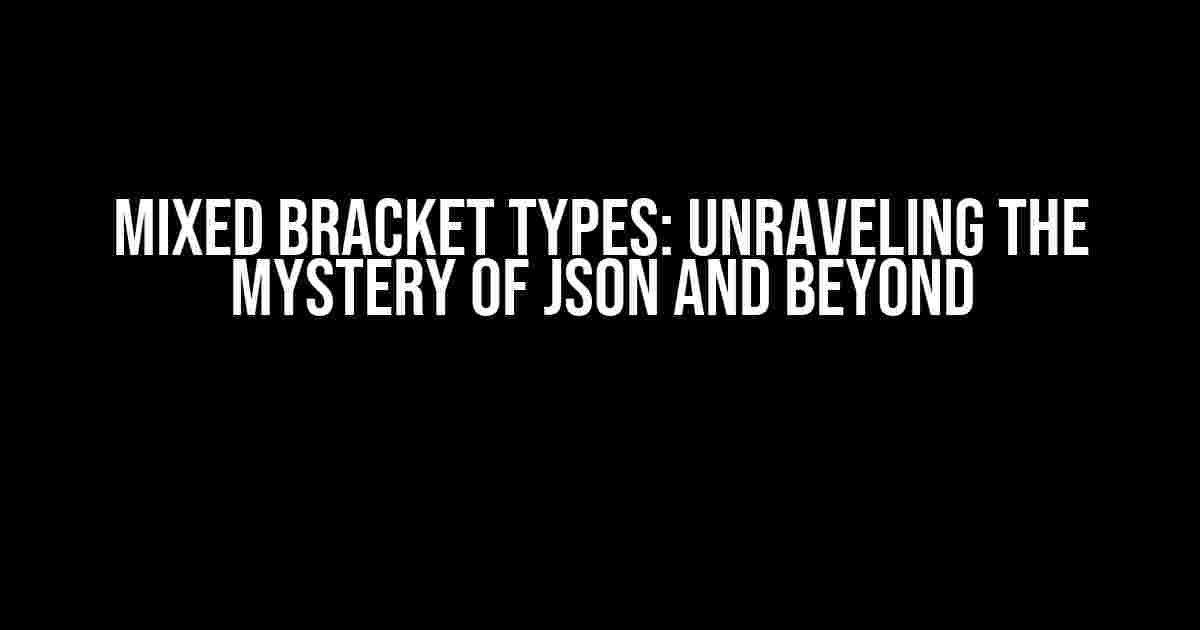Have you ever stumbled upon a code snippet that left you scratching your head, wondering what type of bracketing system is being used? You’re not alone! In this article, we’ll delve into the world of mixed bracket types, exploring the differences between JSON, other data formats, and programming languages. By the end of this journey, you’ll be equipped with the knowledge to identify and work with various bracketing systems like a pro!
What are Mixed Bracket Types?
Mixed bracket types refer to the use of different types of brackets, such as curly braces `{}`, square brackets `[]`, and parentheses `()`, within the same data structure or code snippet. This can lead to confusion, especially for developers new to a particular language or data format.
The Usual Suspects: JSON, XML, and YAML
Let’s start with the most common culprits:
- JSON (JavaScript Object Notation): JSON uses curly braces `{}` to denote objects, square brackets `[]` for arrays, and colons `:` to separate key-value pairs.
- XML (Extensible Markup Language): XML employs angle brackets `<>` to define elements, while attributes are specified using quotes `””`. XML is often used for data exchange and document markup.
- YAML (YAML Ain’t Markup Language): YAML, a human-readable data serialization format, uses colons `:`, dashes `-`, and indentation to denote structure. It’s commonly used for configuration files and data exchange.
// JSON example
{
"name": "John",
"age": 30,
" occupation": "Developer"
}
// XML example
<person>
<name>John</name>
<age>30</age>
< occupation>Developer</occupation>
</person>
// YAML example
name: John
age: 30
occupation: Developer
Programming Languages and Their Bracketing Conventions
Now, let’s explore some popular programming languages and their bracketing conventions:
| Language | Bracket Type | Description |
|---|---|---|
| JavaScript | {} | Denotes objects and object literals |
| Python | [] | Denotes lists and tuples |
| Ruby | {} | Denotes hashes and blocks |
| Java | []() | Denotes arrays and method calls |
| C# | {} | Denotes objects and collections |
When Things Get Mixed Up
So, what happens when you encounter a mix of bracket types in a single code snippet or data structure? This is where things can get confusing:
// Mixed bracket example
[
{
"name": "John",
"age": 30,
( occupation => "Developer" )
},
{
"name": "Jane",
"age": 25,
[ hobbies => "Reading", "Coding" ]
}
]
In this example, we have a mix of JSON-style arrays `[]`, objects `{}`, and parentheses `()`, along with some unconventional syntax. This is not a valid JSON object, but rather a custom data structure that blends different bracketing conventions.
How to Identify and Work with Mixed Bracket Types
When confronted with mixed bracket types, follow these steps to untangle the mess:
- Identify the primary bracket type: Look for the most frequently used bracket type in the code snippet or data structure. This will give you a starting point for understanding the overall structure.
- Determine the context: Consider the programming language, framework, or data format being used. This will help you understand the specific bracketing conventions and syntax.
- Break it down: Split the code into smaller, more manageable chunks, and analyze each component individually. This will help you identify patterns and anomalies.
- Consult documentation and resources: Refer to official documentation, tutorials, and online resources to better understand the specific bracketing conventions and syntax being used.
- Test and validate: Write test code or create a test data structure to validate your understanding of the mixed bracket types.
Conclusion
Mixed bracket types can be intimidating, but by recognizing the different bracketing conventions and following a structured approach, you can effectively identify and work with these complex data structures. Remember, practice makes perfect, so keep exploring and experimenting with different bracketing systems to become a master of mixed brackets!
Now, go forth and conquer the world of mixed bracket types!
Here are 5 Questions and Answers about “Mixed bracket types. Is this json or something else?” :
Frequently Asked Question
Mixed bracket types can be confusing, but don’t worry, we’ve got you covered!
What are mixed bracket types?
Mixed bracket types refer to the use of both curly braces `{}` and square brackets `[]` in a single data structure. This can happen in programming languages like JavaScript, Python, or Ruby, and can be confusing to identify.
Is mixed bracket type a type of JSON?
No, mixed bracket type is not a standard JSON (JavaScript Object Notation) type. JSON uses only square brackets `[]` for arrays and curly braces `{}` for objects. Mixed bracket type is more commonly seen in other data formats or languages.
What languages use mixed bracket types?
Languages like Python, Ruby, and Perl use mixed bracket types in their data structures. For example, in Python, you can define a list using square brackets `[]` and a dictionary using curly braces `{}`. In Ruby, you can use both `[]` and `{}` for arrays and hashes, respectively.
How do I parse mixed bracket types?
Parsing mixed bracket types depends on the language and data structure. In Python, you can use the `ast` module to parse a mixed bracket type data structure. In Ruby, you can use the `JSON` module and specify the parser to use. Always check the language documentation for specific guidance on parsing mixed bracket types.
What are the advantages of mixed bracket types?
Mixed bracket types can provide more flexibility in data representation and make it easier to work with complex data structures. They can also improve code readability and simplify data manipulation. However, it’s essential to use them consistently and follow language-specific conventions to avoid confusion.
